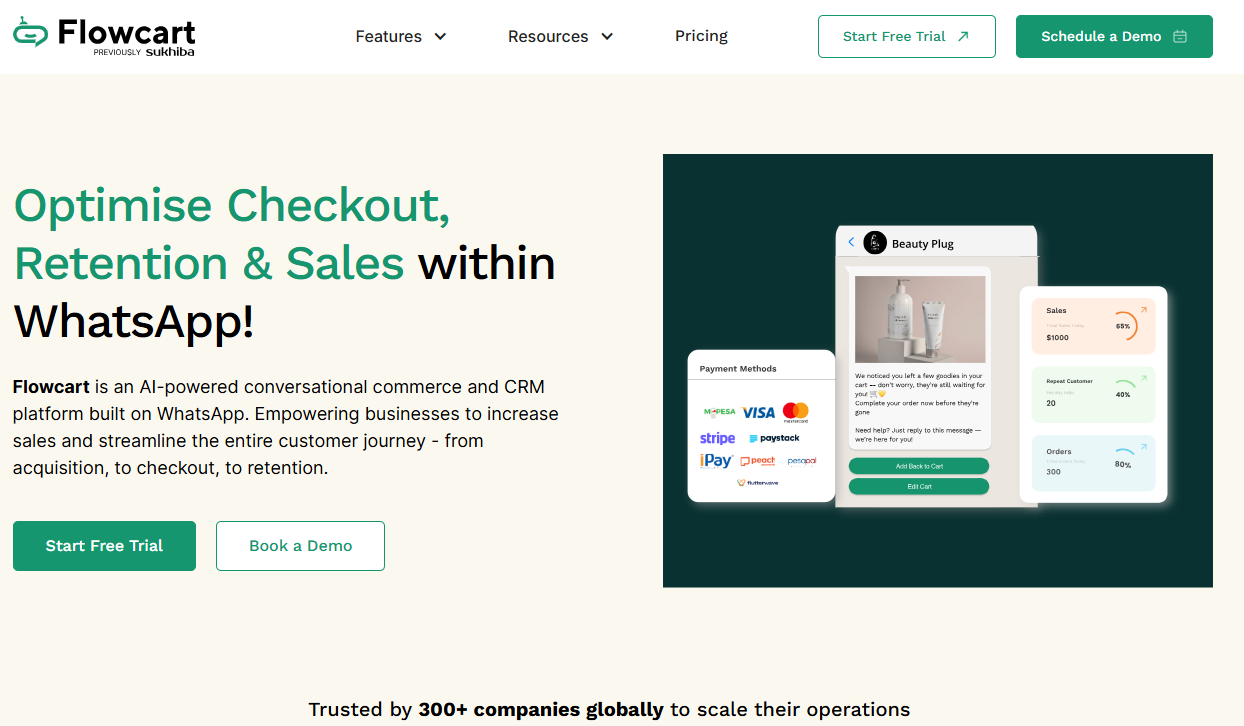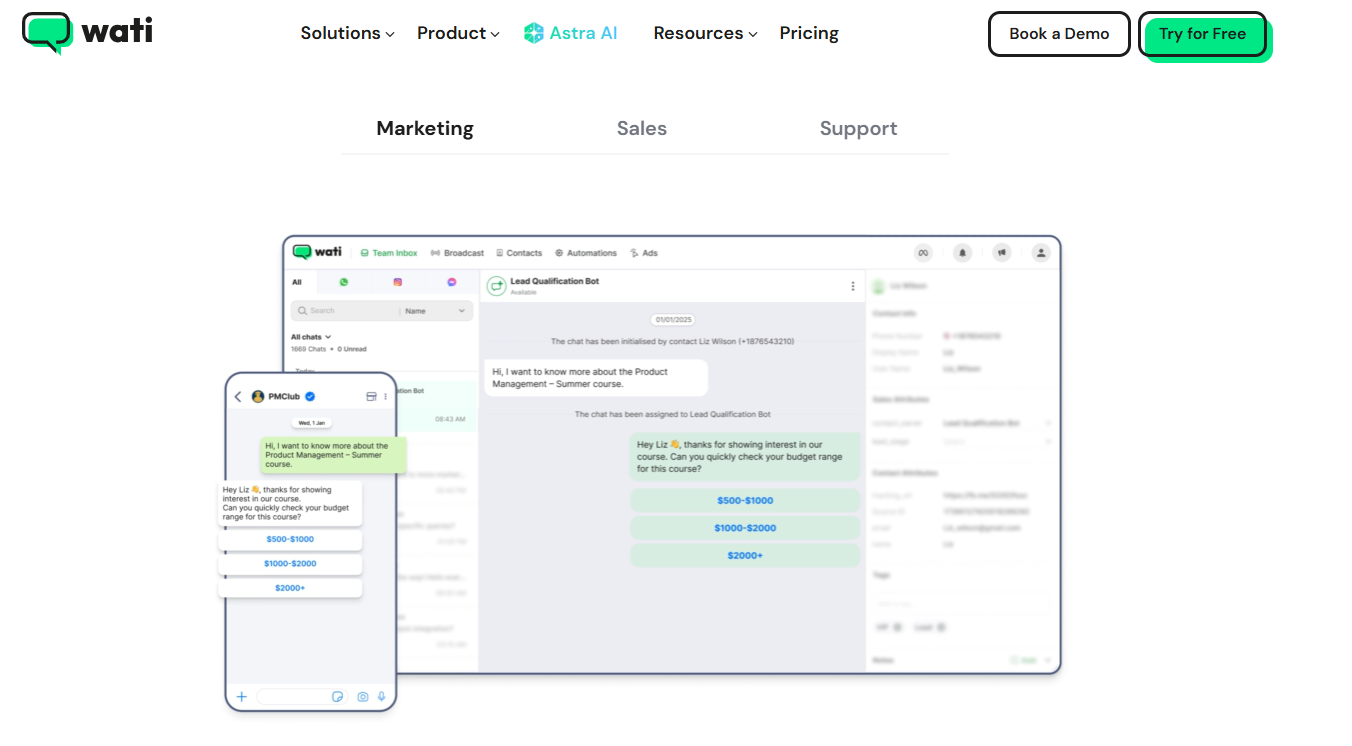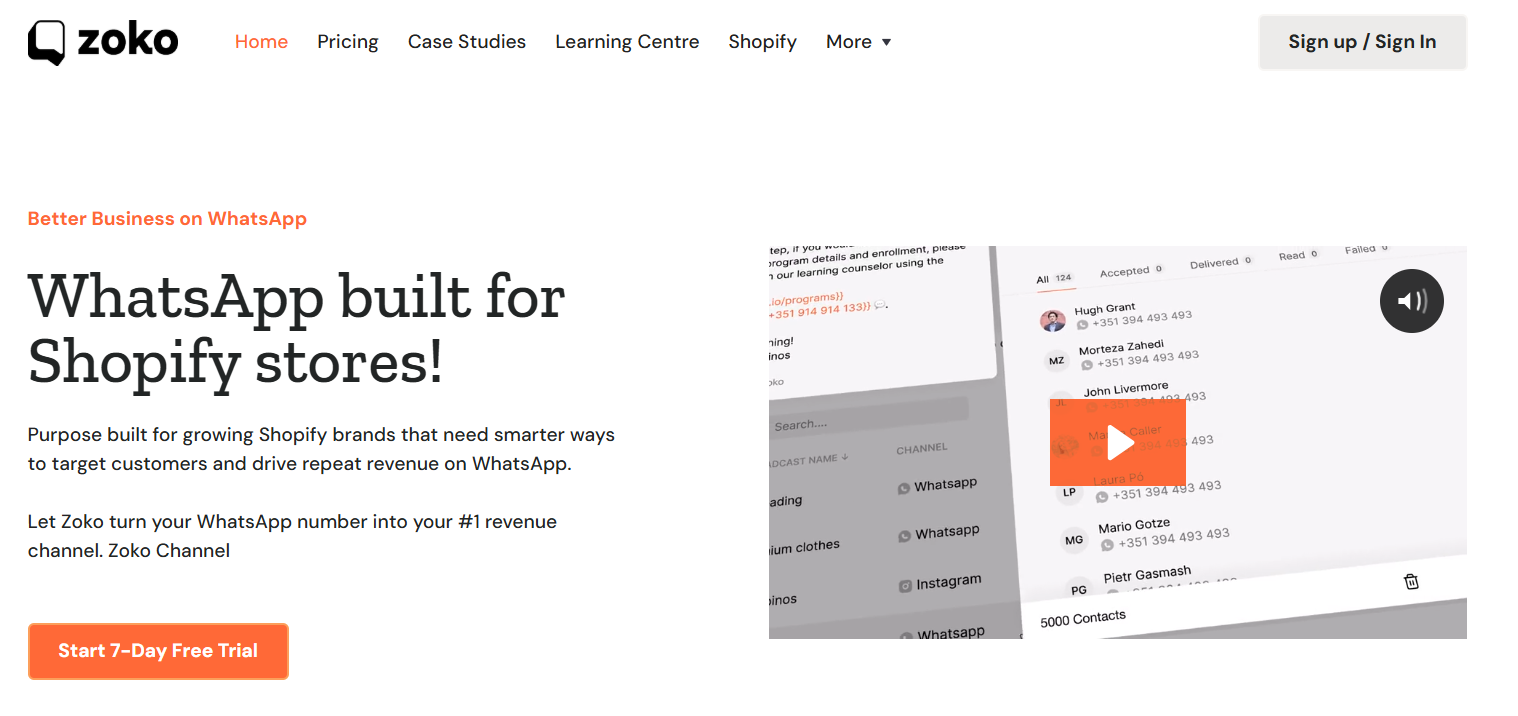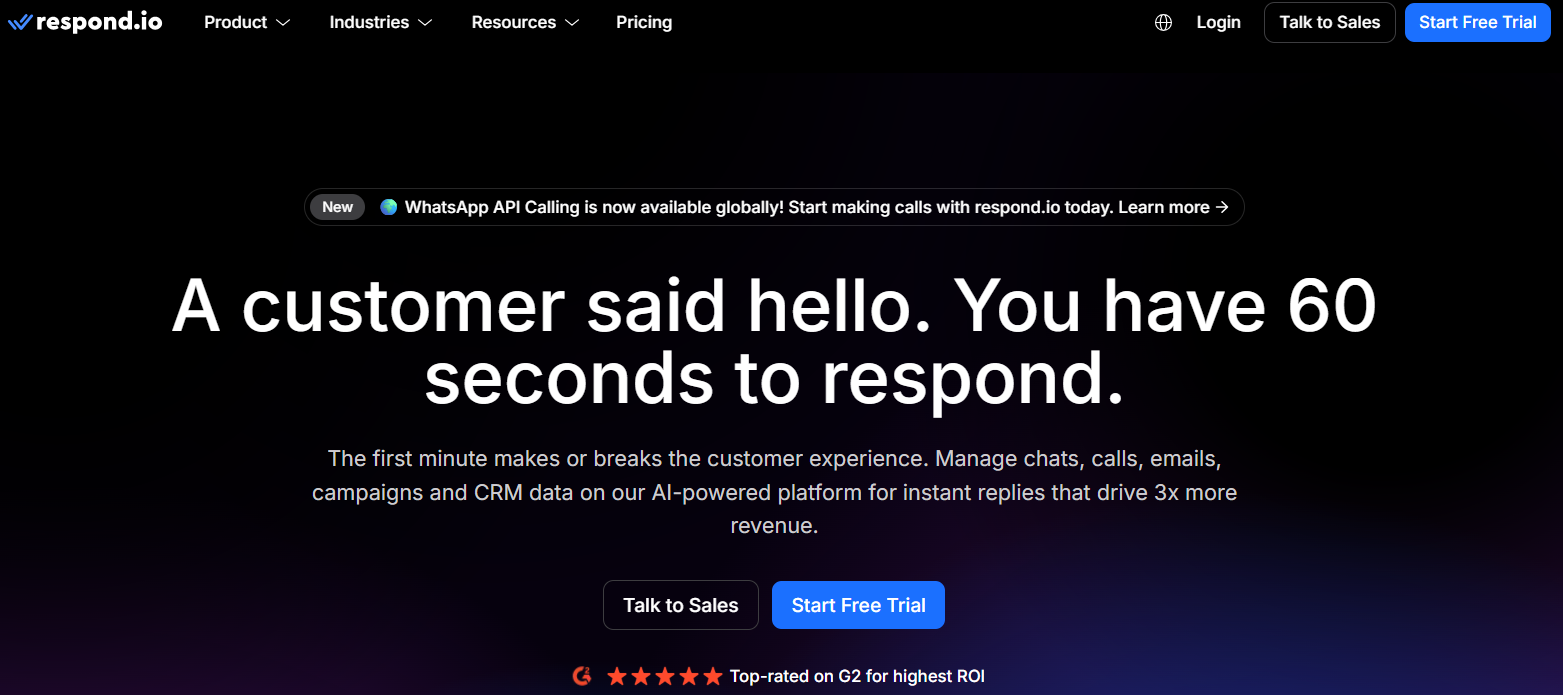In 2024, WhatsApp Business had over 554.7 million daily active users. Customers are already active on this platform, and businesses that once saw WhatsApp as ‘just support’ are now closing deals, sharing catalogs, and recovering carts, all inside the app. I
This guide is your playbook for doing the same. We’ll walk through 10 sales strategies, real examples, and tools (like Flowcart) to show how a simple chat can boost sales on WhatsApp.
Why WhatsApp is a Game-Changer for Sales
Think about how people shop today. They don’t want to fill out long forms, wait for email replies, or browse clunky websites. They want answers now, in the same chat where they send GIFs to their friends.
WhatsApp marketing benefits align well with this framework, turning casual conversations into sales-ready moments. Here’s why businesses that take it seriously can increase sales on WhatsApp faster than anywhere else.
- Supports two-way sales conversations: Customers ask, you answer, and the purchase happens right there.
- Builds trust and reduces friction: A quick product demo, a voice note, or even just a friendly reply can reduce skepticism and speed up decisions.
- Reaps higher engagement: Open rates on WhatsApp are far higher than email, which means your offers actually get seen and acted on before the customer forgets.
- Integrates marketing, sales, and support in one channel: From promotions to questions to closing the deal, it all happens in one thread.
Real-world example: How Kings Wear 4X’ed Sales on WhatsApp
When Kings Collection, a rising fashion brand in Kenya, attempted to scale its online sales, its process was all over the place. Orders came in through scattered calls, DMs, and forms. Fulfillment became messy, updates went missing, and customers were unaware of the status of their orders.
Flowcart moved everything to WhatsApp, including catalog sharing, cart creation, confirmations, and even delivery tracking. They gave customers a simple, one-thread buying experience. And, its AI Agents handled follow-ups, payments, and dispatch coordination without draining the team’s time.
Kings collection achieved 400% growth in online sales and now processes 70% of all orders via WhatsApp. In fact, customers get real-time updates and agents spend less time chasing missed orders.
This is just one instance of many. From fashion brands in Africa to fast-growing D2C startups, companies are already using Flowcart to turn WhatsApp into a revenue engine. Check out more proof of work!
10 Proven Strategies to Boost Sales on WhatsApp
Here are ten WhatsApp marketing strategies to help you turn everyday chats into repeat revenue and boost sales on WhatsApp.
1. Personalized product recommendations
Instead of sending the same message to everyone, tailor product suggestions based on a customer’s browsing history, past purchases, or even questions they’ve asked in chat.
Why it works: Buyers want to feel understood. A recommendation that feels ‘picked just for me’ shortens the decision cycle and builds trust.
How to implement:
- Segment your WhatsApp contacts into categories (first-time buyers, repeat customers, high-value shoppers).
- Use automation to match products with each segment’s preferences.
- Train sales agents (or AI agents) to drop suggestions naturally into conversations.
Pro Tip: Instead of sending a generic product link, pair it with a quick voice note or text message explaining why you’re recommending it. It feels human, builds credibility, and yields higher click-through rates.
2. Sharing catalogs and rich media for guided shopping
WhatsApp catalogs let customers browse and add products to their cart without leaving the app. Pair that with videos, images, and GIFs to make shopping feel like chatting with a stylist or consultant.
Why it works: Rich media reduces buyer hesitation by showing the product in action.
How to implement:
- Set up a WhatsApp Business catalog and update it regularly to ensure it remains accurate and up-to-date.
- Organize products into clear categories (new arrivals, bundles, seasonal picks).
- Share short demo clips, styling guides, or carousel images in response to queries.
Pro Tip: Don’t dump the entire catalog link. Instead, send a curated ‘mini-catalog’ of 2–3 products with a quick note: ‘Based on what you liked last time, here are a few picks for you.’
3. Automated cart recovery messages
When someone adds to the cart but doesn’t complete checkout, send a gentle WhatsApp nudge, ideally within a few hours.
Why it works: Buyers often abandon carts because of distraction, not disinterest. A timely reminder closes the gap before they move on.
How to implement:
- Integrate WhatsApp with your ecommerce store.
- Trigger automation to send reminders within 1–3 hours of abandonment.
- Include product images, pricing, and a one-click checkout link.
Pro Tip: Sweeten the reminder with a micro-incentive, such as free shipping or a bonus sample, something small enough to nudge, yet big enough to convert.
4. Upselling and cross-selling via conversations
Once a customer is engaged, naturally introduce complementary or premium products during the chat.
Why it works: Customers are more open to upgrades or add-ons when they’re already in buying mode.
How to implement:
- Train agents (or AI) to spot upsell triggers: e.g., buying a phone → suggest a case.
- Use saved replies or automation for frequently paired products.
- Always lead with value (‘This bundle saves you 15%’) rather than a pushy pitch.
Pro Tip: Frame upsells as customer wins. Instead of ‘Want to add this?’, say ‘Most people who buy this get X too because it saves reordering later.’
5. Limited-time WhatsApp-only offers
Create exclusive deals that are available only to your WhatsApp audience and set a clear deadline.
Why it works: Exclusivity + urgency are proven sales drivers. It makes buyers feel like insiders and nudges them to act fast.
How to implement:
- Segment a WhatsApp list for VIP/exclusive drops.
- Share the offer with a countdown or expiry time.
- Keep the redemption process seamless with one-click payment links.
Pro Tip: Don’t overuse. Run WhatsApp-only offers on a monthly or quarterly basis so customers actually believe they’re special.
6. Lead nurturing with interactive chat flows
Use automated flows (like quizzes or guided questionnaires) to engage leads, qualify them, and move them toward a purchase.
Why it works: Instead of asking buyers to ‘fill a form,’ you’re having a conversation. It feels natural and keeps them engaged.
How to implement:
- Map out a decision tree (e.g., ‘What’s your skin type?’ → personalized product recommendation).
- Use a tool like Flowcart to build the flow.
- Capture data like preferences, budget, and timeline within the chat.
Pro Tip: End every chat flow with a micro-commitment (a free sample, a first-purchase discount). It keeps the momentum going.
7. Order tracking and post-purchase engagement
Let customers track orders and receive updates directly on WhatsApp. Then use the same thread to upsell or cross-sell later.
Why it works: Customers love transparency. Proactive updates reduce WISMO (‘Where is my order?’) calls and create a chance to re-engage after delivery.
How to implement:
- Integrate your logistics system with WhatsApp.
- Trigger automated updates at each milestone (dispatched, out for delivery, delivered).
- After delivery, check in with a satisfaction survey or next-order incentive.
Pro Tip: Use post-purchase messages to create a community. Invite customers to share photos or reviews right in the chat.
8. Referral and loyalty programs
Encourage happy customers to bring in friends and reward them with discounts, points, or early access to exclusive offers.
Why it works: People trust people more than ads. A recommendation from a friend carries instant credibility, making referrals one of the most cost-effective ways to acquire new customers.
How to implement:
- Create a simple referral link/code that customers can share via WhatsApp.
- Reward both the referrer and the new buyer.
- Use automation to track redemptions and send reminders.
Pro Tip: Don’t bury the referral program in fine print. Deliver it as a fun ‘challenge’, like ‘Nudge 3 friends to sign up this week and unlock X.’
9. Conversational webinars/event signups
Use WhatsApp to invite customers to mini-events (like live product demos or webinars) and manage signups through chat.
Why it works: Events build trust and authority. WhatsApp simplifies registration and reminders, so customers actually show up.
How to implement:
- Share event details via WhatsApp broadcast or flow.
- Use quick-reply buttons for easy RSVP.
- Send automated reminders before the event.
Pro Tip: Follow up with an exclusive event-only offer in the same chat. Attendees are more likely to be warmed up and convert.
Related Read: WhatsApp Conversational Marketing: Strategies, Examples, and Best Practices
10. Fast customer support that drives purchase decisions
Combine automation + human support to answer questions quickly, resolve objections, and keep purchase intent alive.
Why it works: Response time is often the difference between a closed sale and a lost lead. Quick support keeps the buying journey on track.
How to implement:
- Set up a chatbot for FAQs and product queries.
- Route complex queries to human agents for faster closure.
- Use saved responses to maintain a consistent tone.
Pro Tip: Add a ‘Talk to a human agent’ button in your chat flow. The transparency builds trust, and buyers feel in control of the experience.
Best Practices for Selling on WhatsApp
Selling on WhatsApp is about trust. Buyers are inviting you into a personal space they usually reserve for friends and family. Follow these best practices to make sure every conversation drives sales without feeling intrusive or transactional.
- Personalize based on customer behavior: Use purchase history, browsing data, or even simple cues from past conversations to recommend products they’ll actually care about.
- Respond quickly with a human tone: Send a quick, friendly reply to show there’s a real person behind the chat, building trust and nudging buyers toward the checkout.
- Balance automation with live sales agents: Let bots handle routine tasks while agents focus on closing high-value deals.
- Respect message frequency and avoid spam: Stick to relevant updates, timely offers, and meaningful conversations, as over-messaging can lead to being muted or blocked. Keep it lean so every notification feels worth opening.
Tools & Platforms for Boosting Sales on WhatsApp
WhatsApp alone doesn’t give you catalogs, cart recovery, analytics, or sales workflows. That’s where specialized platforms come in: they layer automation, CRM, and AI on top of WhatsApp so you can sell at scale without losing the personal touch.
Here are the leading platforms worth considering to increase sales on WhatsApp, and how they stack up for sales enablement.
1. Flowcart

via Flowcart
Flowcart is a sales-first WhatsApp platform, built to turn conversations into conversions across the entire customer journey. Unlike tools that focus on support or marketing alone, Flowcart combines AI-powered commerce flows, in-chat checkout, and CRM-grade analytics in one place.
It helps businesses acquire, convert, and retain customers without leaving the WhatsApp platform. With 300+ brands already using it to scale, Flowcart is designed for revenue teams that want WhatsApp to operate as a complete storefront.
Curious what it would cost to bring all of this into your own sales process? Explore Flowcart’s pricing, designed to grow with your business, whether you’re just getting started with WhatsApp sales or scaling to thousands of conversations per month.
Key features (and how they increase sales on WhatsApp):
- AI-Powered Checkout & Cart Recovery: Convert intent into purchases directly in chat with automated carts, personalized flows, multiple global payment gateways and timely nudges to recover drop-offs. This closes the gap between browsing and buying in seconds.
- Integrated Campaigns & Engagement Tools: Launch WhatsApp-first campaigns, Click-to-WhatsApp ads, and even interactive polls or quizzes to guide customers toward the right product, turning engagement into trackable revenue.
- CRM & Retention Engine: Manage customer data, order history, and follow-ups inside Flowcart. Automated reminders, personalized offers, and loyalty campaigns keep customers coming back, driving up repeat sales.
Additional Read: The Future of Commerce Is a Conversation And It’s Happening on WhatsApp
2. WATI

via WATI
WATI positions itself as a WhatsApp-first automation platform. Its drag-and-drop flow builder, AI-powered KnowBot, and shared team inbox make it easy to guide customers through product discovery, handle FAQs, and quickly route high-intent leads to sales representatives.
For teams looking to scale less technical conversational workflows, it ticks the right boxes. But it falls short in advanced sales analytics. There’s no built-in ROAS tracking or deep attribution, meaning marketers may struggle to directly tie WhatsApp campaigns to revenue.
Key features (and how they increase sales on WhatsApp):
- Visual Flow Builder for guided commerce: Create multi-step flows (product quizzes, lead qualification, checkout sequences) without engineering. Useful for converting curious browsers into buyers by guiding them to the exact SKU or bundle they need.
- Team Inbox + routing: Shared inbox with auto-assignment so sales reps see context (previous chats, attributes) and pick up hot leads fast, reduces drop-offs when intent is high, and speeds the time-to-purchase.
- KnowBot (AI knowledge base): Train an AI on your product docs, FAQs, or help articles to handle routine questions, freeing human agents to close deals or handle complex objections. This balances 24/7 availability with human escalation for higher-value conversations.
3. Zoko

via Zoko
Zoko is an e-commerce-focused WhatsApp platform with deep Shopify integration as its core strength. Its shared inbox, catalog syncing, and campaign tools are designed for retailers who want to turn WhatsApp into a storefront extension rather than just a support channel.
For Shopify-first brands, it offers a seamless way to manage orders, sync products, and even run Click-to-WhatsApp ads directly. However, its chatbot automation requires add-ons like FlowHippo, making it clunkier if you’re looking for advanced conversational flows.
Key features (and how they increase sales on WhatsApp):
- Shopify Catalog Sync: Keep your WhatsApp catalogs updated in real-time with your Shopify store, so customers always see live product data, creating a seamless shopping journey.
- Campaign & Template Apps: Run promotional campaigns and broadcast product drops without leaving the platform. It drives urgency around new collections or seasonal offers.
- Click-to-WhatsApp Ads: Connect Meta ads to WhatsApp threads, allowing sales reps to close deals instantly and bridge paid traffic with chat-based selling.
4. Respond.io

via Respond.io
Respond.io functions as an omnichannel workspace designed for businesses that want to manage WhatsApp alongside Instagram, Messenger, email, and SMS in a single, clean inbox. It feels enterprise-ready, with strong AI tools, automation workflows, and catalog support that enable mid-sized brands to sell and support their products without juggling multiple platforms.
However, it lags in native ecommerce integrations. There’s no direct Shopify or WooCommerce sync, so connecting storefronts requires external help.
Key features (and how they increase sales on WhatsApp):
- Omnichannel Shared Inbox: Manage WhatsApp sales chats alongside other customer touchpoints, ensuring no lead slips through even if they message on different platforms.
- AI-Powered Messaging: Use built-in ChatGPT tools to draft, translate, or personalize replies instantly, keeping response times short and conversations customer-friendly.
- Campaigns & Segmentation: Run WhatsApp broadcasts targeted by tags and custom fields, so promotions land with the right audience instead of spamming all contacts.
Must Read: Best WhatsApp Marketing Tools to Grow Your Business
How to Implement WhatsApp Sales with Flowcart
From the moment a customer discovers your brand to the point they reorder, Flowcart stitches together every step: catalog browsing, in-chat checkout, cart recovery, and sales analytics. Here’s a step-by-step flow that shows how to set it up and start driving measurable revenue on WhatsApp.
Step 1: Set up your WhatsApp business with Flowcart
Before you can start selling, you need the right infrastructure in place. Flowcart simplifies setup by connecting your business to the official WhatsApp Business API, so you’re not stuck with the limitations of the regular WhatsApp app.
Here’s what happens in this stage:
- Verify your business → Connect your Meta Business account and verify your phone number so customers see a trusted brand identity.
- Activate Flowcart integration → Plug your WhatsApp number into Flowcart’s dashboard, giving you access to campaigns, flows, and automation tools in one place.
- Configure your team → Add sales reps or agents into the shared inbox, set roles, and define routing rules so high-intent conversations never get missed.
- Get templates approved → Upload message templates for order confirmations, cart recovery, and offers. Flowcart handles approval through Meta, so you can start sending right away.
Pro Tip: Don’t treat setup as just a one-time task. Decide early which phone number becomes your official sales channel. A stable, branded WhatsApp identity makes customers far more likely to trust your messages and complete purchases.
Also Read: WhatsApp Marketing Cost: Pricing, Factors, and How to Save Money
Step 2: Build your catalog experience
A WhatsApp catalog works best when it feels like shopping and chatting simultaneously. Instead of forcing customers through redirects and a multi-step purchasing process, Flowcart turns your chat thread into a complete, store-like experience where browsing, checkout, and confirmation all happen in one place.
With Flowcart’s catalog tools, the experience goes beyond static product listings. You can guide customers through personalized carts and frictionless in-chat payments. For example:
- In-Chat Checkout becomes a repeatable flow for product launches, allowing customers to browse, pay, and confirm delivery all within WhatsApp. Every detail, from address autofill to payment options, is handled seamlessly inside chat, reducing drop-offs.
- AI-Generated Carts act as personalized assistants inside conversations. The AI asks simple questions (budget, style, preferences) and instantly builds a ready-to-checkout cart. Agents can step in with bundles or upsells, or let AI close the sale automatically.
Once set up, these catalog flows save your team effort and create a smooth, repeatable experience for buyers, whether they’re making their first purchase or reordering.
Pro Tip: Create ‘smart carts’ for your most common journeys, like reorders, seasonal bundles, or first-purchase discounts. These micro-templates reduce buyer effort and give your sales team a proven way to lift order value without adding extra steps.
Step 3: Automate conversations that convert
Sales on WhatsApp don’t scale if every chat needs a manual reply. That’s where Flowcart’s automation comes in, using AI-driven flows and campaign-specific journeys to guide customers from ‘hello’ to checkout automatically.
With Flowcart’s automation tools, every touchpoint can be turned into a sale-ready flow. For example:
- WhatsApp Flows let customers view catalogs, check past orders, or connect with a live agent in a few taps. AI learns from shopping history and routes each person to the right journey, reducing bounce rates and lifting conversions on first sessions by 28%.
- Click-to-WhatsApp Ads turn campaign clicks into instant conversations. Instead of sending traffic to a landing page, Flowcart opens a tailored WhatsApp flow that matches the ad’s promise. Every ad click becomes a guided sale, with merchants reporting 5× ROAS and 23% fewer abandoned carts.
Once in place, these automations answer questions and sell for you. They ensure that campaigns, conversations, and carts work together so that no intent is wasted.
Pro Tip: Map your automations around customer intent triggers, like ‘clicked an ad,’ ‘asked about delivery,’ or ‘looked at past orders.’ The more specific your flows, the less generic they feel, and the faster customers move to checkout.
Step 4: Measure, segment, and grow with analytics
Analytics on WhatsApp is about knowing who to target, when to target them, and how to keep them coming back. Flowcart makes analytics actionable by pairing performance insights with segmentation, campaigns, and loyalty flows that directly increase revenue.
With Flowcart’s analytics suite, you move from vanity metrics to revenue visibility. For example:
- AI-Powered Segmentation automatically groups customers based on purchase history, engagement, cart size, or lifecycle stage.
- Smart Broadcasts turn those segments into ROI-driven campaigns. Instead of mass messaging, you deliver offers, polls, product carousels, or one-tap carts directly inside chat. Every broadcast is tracked for opens, clicks, and conversions, so your sales team sees what works and doubles down.
- Loyalty Programs in WhatsApp make retention measurable. Customers can check points, redeem rewards, or unlock seasonal perks directly in chat. For brands, this means higher lifetime value and more repeat sales, all without additional ad spend.
Once these analytics-driven flows are in place, every campaign becomes measurable, every message has ROI, and every customer touchpoint is tracked back to revenue.
Pro Tip: Segment by demographic and intent. For example, ‘added to cart but didn’t buy’ or ‘redeemed points but hasn’t purchased in 60 days.’ These micro-segments often deliver the biggest conversion jumps when paired with timely offers.
From setup to catalog, automation, and analytics, Flowcart gives you everything you need to turn WhatsApp into a full-funnel sales channel. Instead of juggling disjointed tools, you get one platform that helps your team acquire, convert, and retain customers inside the same conversation.
If you’re ready to see how Flowcart can fit into your business, the next step is simple: book a demo. Our team will walk you through real use cases, show you how other brands are scaling revenue on WhatsApp, and help you set up a flow tailored to your goals.
FAQs
How can small businesses boost sales on WhatsApp without large teams?
Small businesses can rely on automations, such as cart recovery reminders or product flows, so sales reps only step in when a human touch is truly needed. Tools like Flowcart make it possible to scale engagement without adding headcount.
What’s the ROI of WhatsApp sales strategies?
ROI depends on how you use the channel, but brands on WhatsApp typically see higher conversions and lower acquisition costs. With 95% of WhatsApp messages read in minutes, engagement rates are naturally strong, making ROI easier to achieve than with channels like SMS or email.
Is WhatsApp better than email for sales conversions?
Yes. WhatsApp messages are read almost instantly, while emails often get lost or ignored. WhatsApp feels more personal, which makes buyers more likely to respond and complete purchases, especially when conversations occur in real-time.
Can WhatsApp be integrated with ecommerce stores?
Absolutely. Platforms like Flowcart connect seamlessly with Shopify, WooCommerce, and ERPs so your product catalog, payments, and order tracking work inside WhatsApp. This ensures conversations translate directly into sales.
How do I measure sales performance on WhatsApp?
You can track key metrics like open rates, clicks, conversions, and revenue impact through analytics dashboards. Flowcart goes a step further by tying these metrics back to customer segments and campaigns, so you can see which messages actually drive sales growth.
.png)


.png)
.png)


%201.webp)



